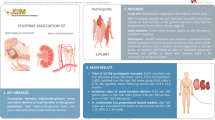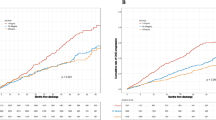Abstract
We sought to determine the prevalence of hyperinsulinemia and insulin resistance in pediatric patients with chronic kidney disease (CKD) stages 2–4. Data were collected on 43 subjects, aged 6–21 years with mean glomerular filtration rate (GFR) = 47 ml/min per 1.73 m2 body surface area. Patients were grouped by body mass index (BMI) as either non-lean (>85th percentile) or lean (≤85th percentile). Fourteen (33%) subjects had hyperinsulinemia, and seven (16%) had elevated homeostasis model assessment of insulin resistance (HOMA-IR). Non-lean subjects had a higher serum insulin level (21.0 μU/ml vs 13.4 μU/ml, P < 0.0001) and HOMA-IR (4.9 vs 3.2, P < 0.001) than lean subjects had. The prevalence of hyperinsulinemia was higher in non-lean patients (40%) than in lean patients (29%) but was not statistically significant. High HOMA-IR was present in six (40%) non-lean subjects and in one lean subject (P < 0.001). Correlation analysis demonstrated that serum insulin level was significantly associated with BMI, leptin and tumor necrosis factor (TNF)-α. Stepwise regression determined that increased BMI (P = 0.003) and TNF-α (P = 0.01) independently predicted higher insulin level in the whole cohort. Separate analysis for lean subjects showed no significant associations between serum insulin level and BMI; TNF-α was the only independent predictor of serum insulin (β = 1.11, P = 0.01). We conclude that hyperinsulinemia and insulin resistance are frequent in pediatric CKD. In lean patients inflammation appears to be an important determinant of serum insulin level.

Similar content being viewed by others
Abbreviations
- CV:
-
cardiovascular
- CKD:
-
chronic kidney disease
- GFR:
-
glomerular filtration rate
- TNF-α:
-
tumor necrosis factor-α
- hsCRP:
-
high-sensitivity C-reactive protein
- IL:
-
interleukin
- BMI:
-
body mass index
- SBP:
-
systolic blood pressure
- DBP:
-
diastolic blood pressure
- HOMA-IR:
-
homeostasis model assessment of insulin resistance
- NFκB:
-
nuclear factor κB
- IRS-1:
-
insulin receptor substrate-1
References
Sechi LA, Catena C, Zingaro L, Melis A, De Marchi S (2002) Abnormalities of glucose metabolism in patients with early renal failure. Diabetes 51:1226–1232
Shinohara K, Shoji T, Emoto M, Tahara H, Koyama H, Ishimura E, Miki T, Tabata T, Nishizawa Y (2002) Insulin resistance as an independent predictor of cardiovascular mortality in patients with ESRD. J Am Soc Nephrol 13:1894–2000
Knight EL, Rimm EB, Pai JK, Rexrode KM, Cannuscio CC, Manson JE, Stampfer MJ, Curhan GC (2004) Kidney dysfunction, inflammation and coronary events: a prospective study. J Am Soc Nephrol 15:1897–1903
Chen J, Muntner P, Hamm LL, Fonseca V, Batuman V, Whelton PK, He J (2003) Insulin resistance and risk of chronic kidney disease in nondiabetic US adults. J Am Soc Nephrol 14:469–77
Mak RH (1995) Insulin secretion and growth failure in uremia. Pediatr Res 38:378–383
El-Bishti M, Counahan R, Jarrett RJ (1977) Hyperlipidemia in children on regular hemodialysis. Arch Dis Child 15:932–936
Parra A, Lopez-Uriarte A, Argote RM, Garcia G, Ledon S, Santos D (1979) Effect of hemodialysis on glucose tolerance in children with chronic renal failure. Arch Invest Med (Mex) 10:39–52
Buyan N, Bideci A, Ozkaya O, Ortac E, Bakkaloglu S, Gonen S, Peru H, Soylemezoglu O, Cinaz P (2006) Leptin and resistin levels and their relationships with glucose metabolism in children with chronic renal insufficiency and undergoing dialysis. Nephrology 11:192–196
Shishido S, Sato H, Asanuma H, Shindo M, Hataya H, Ishikura K, Hamasaki Y, Goto M, Ikeda M, Honda M (2006) Unexpectedly high prevalence of pretransplant abnormal glucose tolerance in pediatric kidney transplant recipients. Pediatr Transplant 10:1–4
Haffner D, Nissel R, Wuhl E, Schaefer F, Bettendorf M, Tonshoff B, Mehls O (1998) Metabolic effects of long-term growth hormone treatment in prepubertal children with chronic renal failure and after kidney transplantation. The German Study Group for Growth Hormone Treatment in Chronic Renal Failure. Pediatr Res 43:209–215
Stake G, Monclair T (1991) A single plasma sample method for estimation of the glomerular filtration rate in infants and children using iohexol: establishment of a body weight-related formula for the distribution volume of iohexol. Scand J Clin Lab Invest 51:335–342
Schwartz GJ, Gauthier B (1985) A simple estimate of glomerular filtration rate in adolescent boys. J Pediatr 106:522–526
Weiss R, Dziura J, Burgert TS, Tamborlane WV, Taksali SE, Yeckel CW, Allen K, Lopes M, Savoye M, Morrison J, Sherwin RS, Caprio S (2004) Obesity and the metabolic syndrome in children and adolescents. N Engl J Med 350:2362–2374
Lee JM, Okumura MJ, Davis MM, Herman WH, Gurney JG (2006) Prevalence and determinants of insulin resistance among US adolescents: a population-based study. Diabetes Care 29:2427–2432
Kalantar-Zadeh K, Block G, Humphreys MH, Kopple JD (2003) Reverse epidemiology of cardiovascular risk factors in maintenance dialysis patients. Kidney Int 63:793–808
Santoro A, Mancini E (2002) Cardiac effects of chronic inflammation in dialysis patients. Nephrol Dial Transplant 17 [Suppl 8]:10–15
Churchill DN, Taylor W, Keshaviah PR (1996) Adequacy of dialysis and nutrition in continuous peritoneal dialysis: association with clinical outcomes. CANUSA Peritoneal Dialysis Study Group. J Am Soc Nephrol 7:198–207
Kaysen GA (2006) Association between inflammation and malnutrition as risk factors of cardiovascular disease. Blood Purif 25:51–55
Kaysen GA (2001) The microinflammatory state in uremia: causes and potential consequences. J Am Soc Nephrol 12:1549–1557
Steinvenkel P, Ketteler M, Johnson RJ (2005) IL-10, IL-6, and TNF-α: central factors in the altered cytokine network of uremia—the good, the bad, the ugly. Kidney Int 67:1216–1223
Oberg BP, McMenamin E, Lucas FL, McMonagle E, Morrow J, Ikizler TA, Himmelfarb J (2004) Increased prevalence of oxidant stress and inflammation in patients with moderate to severe chronic kidney disease. Kidney Int 65:1009–1016
Pereira BJ, Shapiro L, King AJ, Falagas ME, Strom JA, Dinarello CA (1994) Plasma levels of IL-1β, TNF-α and their specific inhibitors in undialyzed chronic renal failure, CAPD and hemodialysis patients. Kidney Int 45:890–896
Witko-Sarsat V, Friedlander M, Nguyen Khoa T, Capeillere-Blandin C, Nguyen AT, Canteloup S, Dayer JM, Jungers P, Drueke T, Descamps-Latscha B (1998) Advanced oxidation protein products as novel mediators of inflammation and monocyte activation in chronic renal failure. J Immunol 161:2524–2532
Ceballos-Picot I, Witko-Sarsat V, Berad-Boudia M, Nguyen AT, Thévenin M, Jaudon MC, Zingraff J, Verger C, Jungers P, Descamps-Latscha B (1996) Glutathione antioxidant system as a marker of oxidative stress in chronic renal failure. Free Rad Biol Med 21:845–853
Guarnieri G, Antonione R, Biolo G (2003) Mechanisms of malnutrition in uremia. J Ren Nutr 13:153–157
Reid MB, Li YP (2001) Tumor necrosis factor-α and muscle wasting: a cellular perspective. Respir Res 2:269–272
Guttridge DC, Mayo MW, Madrid LV, Wang CY, Baldwin AS Jr (2000) NF-kappaB-induced loss of MyoD messenger RNA: possible role in muscle decay and cachexia. Science 289:2363–2366
Li YP, Reid MB (2000) NF-κB mediates the protein loss induced by TNF-α in differentiated skeletal muscle myotubes. Am J Physiol Regul Integr Comp Physiol 279:R1165–R1170
Li Y, Schwartz RJ, Waddell ID, Holloway BR, Reid MB (1998) Skeletal muscle myocytes undergo protein loss and reactive oxygen-mediated KF-κB activation in response to tumor necrosis factor α. FASEB J 12:871–880
Sen CK, Khanna S, Reznick AZ, Roy S, Packer L (1997) Glutathione regulation of tumor necrosis factor α-induced NF-κB activation in skeletal muscle-derived L6 cells. Biochem Biophys Res Com 237:645–649
Buck M, Chojkier M (1996) Muscle wasting and dedifferentiation induced by oxidative stress in a murine model of cachexia is prevented by inhibitors of nitric oxide synthesis and antioxidants. EMBO J 15:1753–1765
Brenner DA, Buck M, Feitelberg SP, Chojkier M (1990) Tumor necrosis factor-α inhibits albumin gene expression in a murine model of cachexia. J Clin Invest 85:248–255
Hotamisligil GS, Budavari A, Murray D, Spiegelman BM (1994) Reduced tyrosine kinase activity of insulin receptor in obesity-diabetes: central role of tumor necrosis factor-α. J Clin Invest 94:1543–1549
Cheung AT, Ree D, Kolls JK, Feselier J, Coy DH, Breyer-Ash M (1998) An in vivo model for elucidation of the mechanism of tumor necrosis facto- α (TNF-α) induced insulin resistance: evidence for differential regulation of insulin signalling by TNF-α. Endocrinology 139:4928–4935
Breder CD, Hazuka C, Ghayur T, Klug C, Huginin M, Yasuda K, Teng M, Saper CB (1994) Regional induction of tumor necrosis factor α expression in the mouse brain after systemic lipopolysaccharide administration. Proc Natl Acad Sci USA 91:11393–11397
Author information
Authors and Affiliations
Corresponding author
Rights and permissions
About this article
Cite this article
Lai, H.L., Kartal, J. & Mitsnefes, M. Hyperinsulinemia in pediatric patients with chronic kidney disease: the role of tumor necrosis factor-α. Pediatr Nephrol 22, 1751–1756 (2007). https://doi.org/10.1007/s00467-007-0533-z
Received:
Revised:
Accepted:
Published:
Issue Date:
DOI: https://doi.org/10.1007/s00467-007-0533-z




